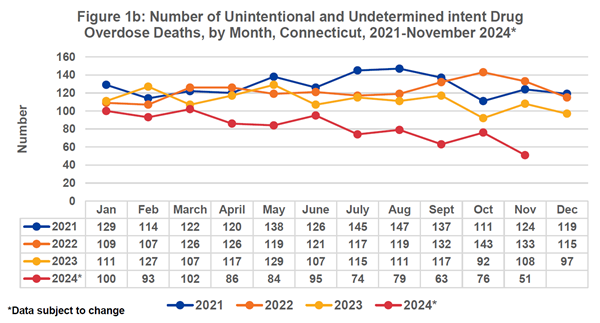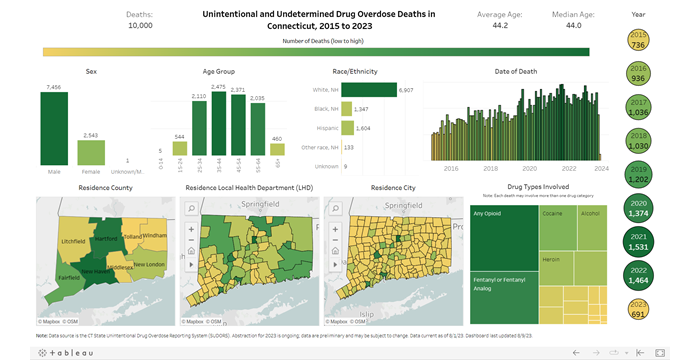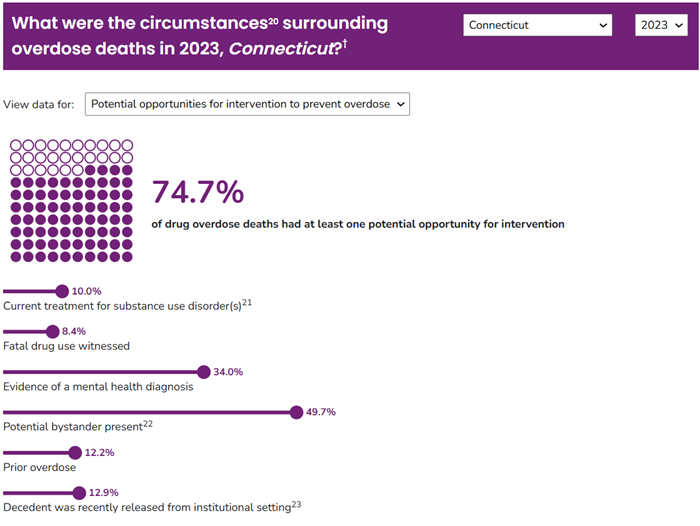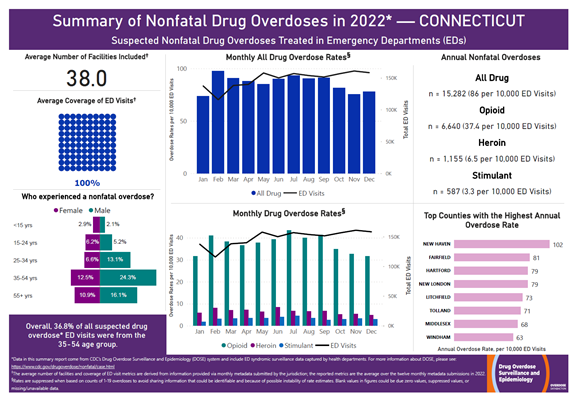Opioid and Drug Overdose Statistics
In Connecticut, residents are more likely to die from unintentional drug overdose than a motor vehicle crash. The majority of these deaths are linked to overdose of illicit opioids. According to the CDC, the 2023 Connecticut age-adjusted rate for unintentional drug-induced mortality was 33.3 per 100,000 population compared to the 2023 national rate of 29.1.
State Unintentional Drug Overdose Reporting System:
The Connecticut Department of Public Health (CT DPH) is funded by the CDC to participate in the State Unintentional Drug Overdose Reporting System (SUDORS) to collect comprehensive data on unintentional and undetermined intent overdose deaths within the state. Data is abstracted from multiple data sources including death certificates, medical examiner reports, and postmortem toxicology results. SUDORS captures information on variables such as demographics, circumstances, scene evidence, and substances contributing to the death for each overdose death.
Monthly Drug Overdose Death Report
Emerging Substances Death Report
The Emerging Substances Report provides an overview and finalized data on the rise of three substances of interest in fatal overdoses in Connecticut since 2020, specifically involving bromazolam, carfentanil, and nitazenes. The findings indicate continued increases in the presence and impact of these substances. The report features informative charts and tables illustrating yearly trends, demographic patterns, and geographic distributions of the overdose fatalities. The goal is to raise awareness and highlight the ongoing situation surrounding these emerging substances.
Drug Overdose Death Fact Sheets
- Unintentional Drug Overdose Deaths in CT (2024) Fact Sheet
- Unintentional Drug Overdose Deaths in CT (2023) Fact Sheet
- Unintentional Drug Overdose Deaths in CT (2022) Fact Sheet
- Unintentional Drug Overdose Deaths in CT (2021) Fact Sheet
- Unintentional Drug Overdose Deaths in CT (2020) Fact Sheet
CT SUDORS Dashboard
The CT DPH presents an interactive dashboard showcasing data from SUDORS on drug overdose deaths to increase public awareness about the impact of the drug overdose crisis in Connecticut. In this dashboard, demographic, geographic, and type of drug-related overdose information can be visualized through the years from 2015 to 2025.
To navigate the dashboard, hover over maps and charts to show more details. To view the dashboard for selected years, time periods, demographics, or types of drugs involved, single-click on these sections. Click again on the selected sections to go back to the original view or click the reset button on the bottom right of the screen.
CDC SUDORS Dashboard and Infographic
CDC also publishes a national dashboard for SUDORS data, which can be found here. The dashboard can be filtered to show data specifically for Connecticut.
For more information on drug overdose death data, please see here for statistics posted by the Connecticut Office of the Chief Medical Examiner:
EpiCenter Syndromic Surveillance System:
The CT DPH uses syndromic surveillance system data from the EpiCenter system to provide near real-time estimates of emergency department (ED) utilization for suspected drug overdoses in order to quickly detect and respond to changes in patterns of both fatal and nonfatal overdoses. Please see the following links for preliminary data maps on ED utilization for suspected overdoses due to all drugs (including all opioids, stimulants, and benzodiazepines), all opioids (including prescription painkillers and fentanyl/analogs), heroin, cocaine, and stimulant overdoses.
EpiCenter Syndromic Surveillance Maps by Local Health Department/District (LHD)
- Suspected All Drug Overdoses by LHD, 2024
- Suspected All Drug Overdoses by LHD, 2023
- Suspected All Drug Overdoses by LHD, 2022
- Suspected All Drug Overdoses by LHD, 2021
- Suspected Opioid Overdoses by LHD, 2024
- Suspected Opioid Overdoses by LHD, 2023
- Suspected Opioid Overdoses by LHD, 2022
- Suspected Opioid Overdoses by LHD, 2021
- Suspected Stimulant Overdoses by LHD, 2022-2024
- Suspected Stimulant Overdoses by LHD, 2021-2023
- Suspected Cocaine Overdoses by LHD, 2022-2024
- Suspected Cocaine Overdoses by LHD, 2021-2023
- Suspected Heroin Overdoses by LHD, 2022-2024
- Suspected Heroin Overdoses by LHD, 2021-2023

Drug Overdose Surveillance and Epidemiology (DOSE) Reports and Dashboard
The nonfatal drug overdose data on this dashboard come from CDC’s Drug Overdose Surveillance and Epidemiology (DOSE) system, which captures electronic health record information in syndromic surveillance systems. This dashboard represents the most up-to-date data that the CDC’s DOSE system has available and is updated shortly after new data are made available each month. Currently, 46 states and the District of Columbia share data with DOSE, and states that do not share these data are labeled “data not available” or “unfunded state.”
Non-Fatal Drug Overdose Report:
The Non-Fatal Drug Overdose Report encompasses drug overdose data spanning 2020-2024. The report describes the burden of suspected non-fatal drug overdose incidents in Connecticut, including demographic information like Age, Sex, and Race-Ethnicity. Data are gathered from the Electronic Surveillance System for the Early Notification of Community-based Epidemics (ESSENCE) to access near real-time emergency department and urgent care visits in Connecticut. The data in this report are considered preliminary and should be used for situational awareness.
For additional data reports on drug and opioid overdoses, please see the following links:
- Connecticut Drug Overdose Emergency Department Visit Report, September 2025
- Unintentional Drug Overdose Deaths Involving Different Drugs in CT (2012-2024) - Toxicology Tables
Naloxone Distribution and Training Through the Department of Correction:
To reduce fatal opioid overdoses among recently incarcerated individuals, the Connecticut Department of Correction (CT DOC) provides naloxone (NARCAN) and the accompanying training at various touchpoints post-incarceration. The Addiction Treatment Unit staff at CT DOC distribute naloxone and provide training on naloxone administration to the following: inmates upon release or discharge, offenders on community supervision, sponsors of inmates preparing for discharge, and sponsors of offenders currently on parole. Over time, the number of participating CT DOC facilities, halfway houses and parole offices has expanded; as of January 2022, 100% of CT DOC facilities and parole offices are participating in naloxone distribution and training. In addition, the CT DOC trains every staff member on signs of an opioid overdose and how to respond with naloxone. This lifesaving medication is also strategically placed throughout all correctional facilities so that overdoses can be treated with naloxone by any staff person.
- Naloxone Distribution and Training Data Report, January to December 2024
- Naloxone Distribution and Training Data Report, January to December 2023
- Naloxone Distribution and Training Data Report, January to December 2022
- Naloxone Distribution and Training Data Report, June 2020 to April 2022
Prescription Monitoring and Reporting System:
The Connecticut Department of Consumer Protection reports data on various indicators related to opioid prescribing and dispensing practices throughout the state collected through the Connecticut Prescription Monitoring and Reporting System (CPMRS). The CPMRS is a centralized database used to track prescription data for Schedule II through Schedule V drugs. The CPMRS is also utilized by healthcare providers and pharmacists in the active treatment of their patients. The purpose of the CPMRS is to present a complete picture of a patient’s controlled substance use, including prescriptions by other providers.
- Prescription Monitoring and Reporting System Data Linking Report, 2020-2023
- Prescription Monitoring and Reporting System Data Linking Report, 2020-2022
Quarterly Prescription Monitoring and Reporting System Reports
- 2025 Q1 - January to March
- 2024 - January to December
- 2023 - January to December
- 2022 - January to December
Quarterly Prescription Monitoring and Reporting System Maps by Local Health Department/District (LHD)
- 2025 Q1 - January to March
- 2024 Q4 - October to December
- 2024 Q3 - July to September
- 2024 Q2 - April to June
- 2024 Q1 - January to March
- 2023 Q4 - October to December
- 2023 Q3 - July to September
- 2023 Q2 - April to June
- 2023 Q1 - January to March
- 2022 Q4 - October to December
- 2022 Q3 - July to September
- 2022 Q2 - April to June
- 2022 Q1 - January to March
For more information on the CPMRS and access to additional data reports, please see here:
Data Requests
- If requesting data for purposes of research, the requestor must submit through the DPH Human Investigations Committee (HIC), fulfilling the role of the Department’s Institutional Review Board (IRB). Information on this process can be found on the DPH HIC webpage.
If requesting aggregate data for purposes such as surveillance, program planning, or policy development, the following form can be completed and submitted to the Injury and Violence Surveillance Unit (IVSU). Requests will typically be processed within 5 to 10 business days.
For more information, please call
The Office of Injury and Violence Prevention





